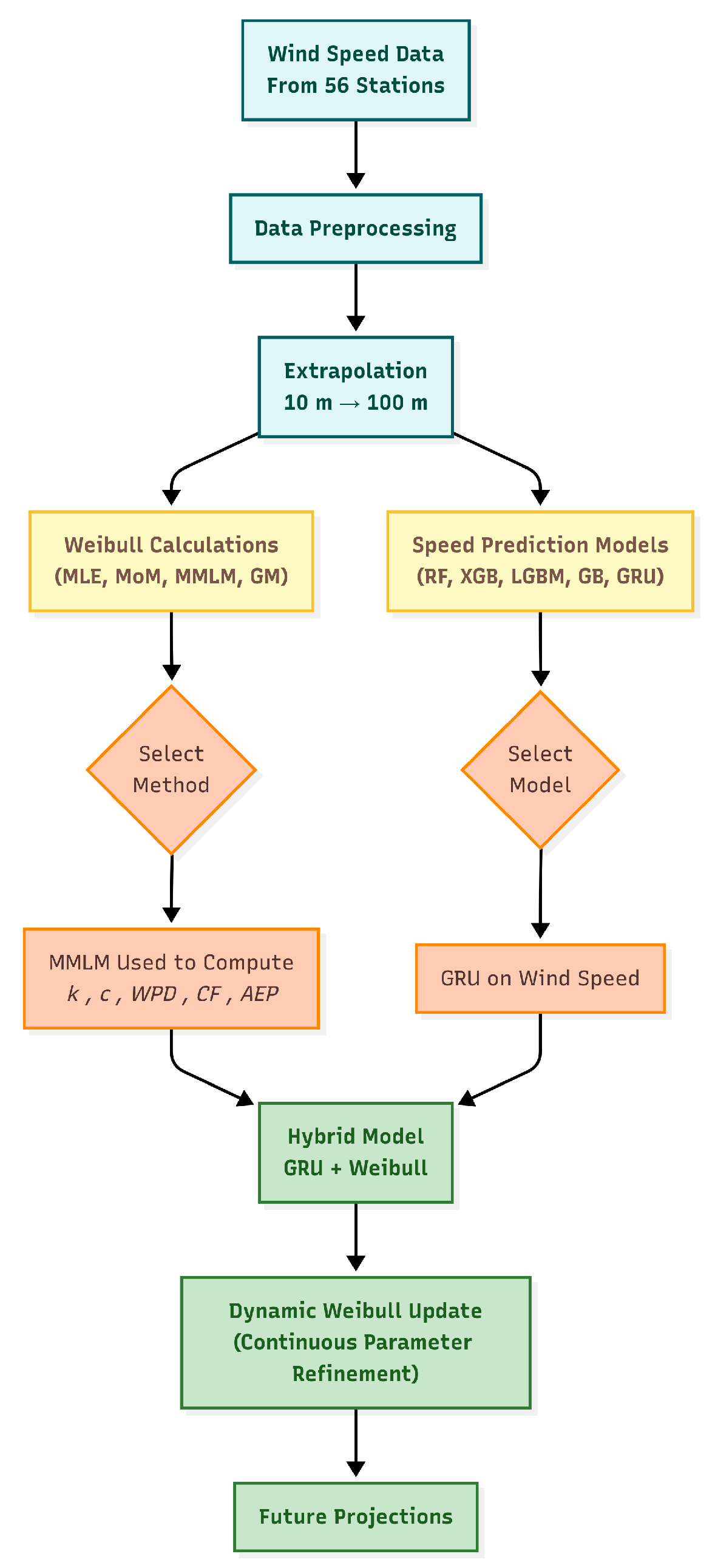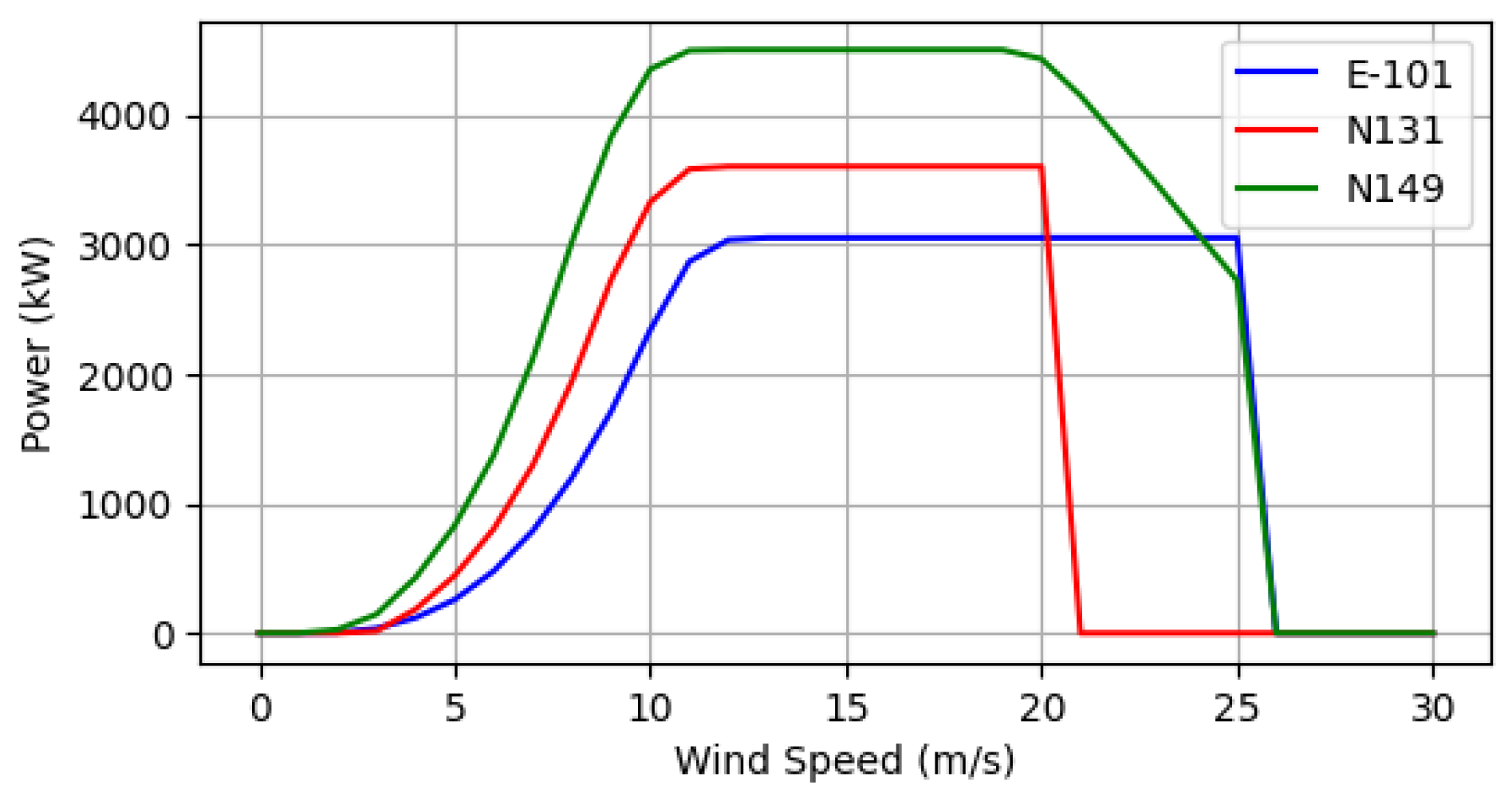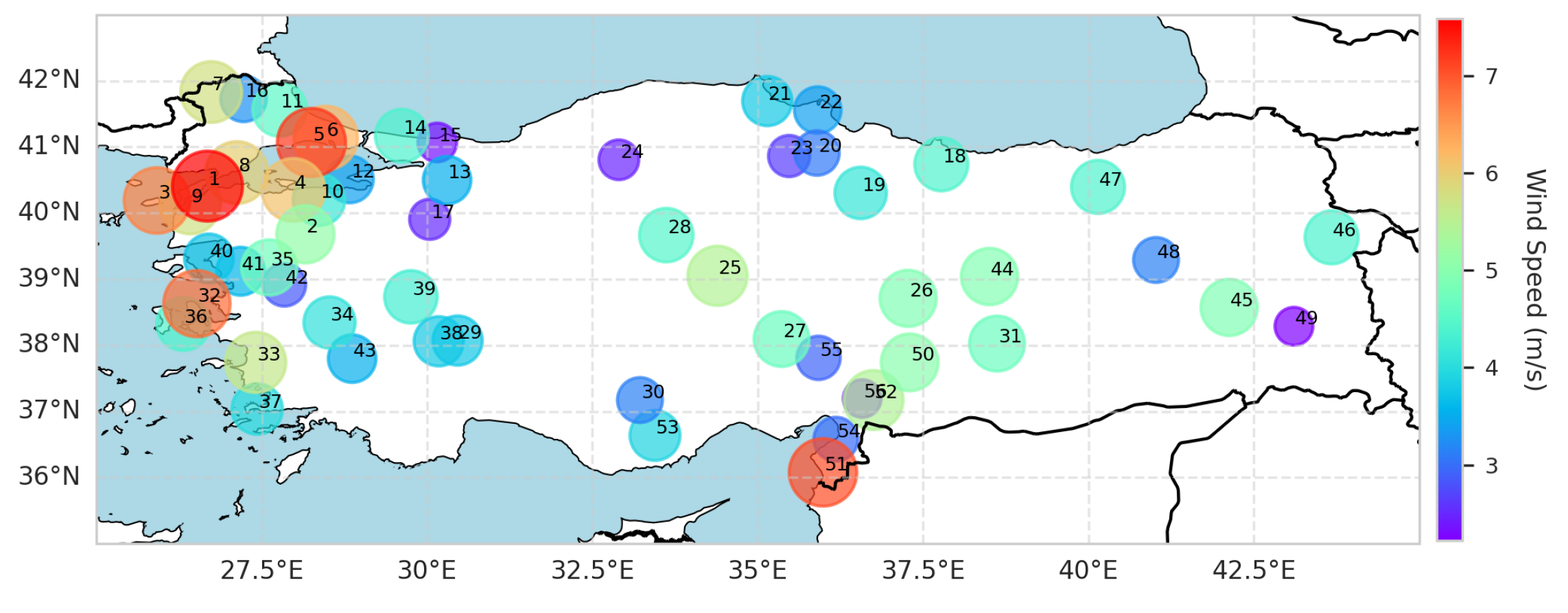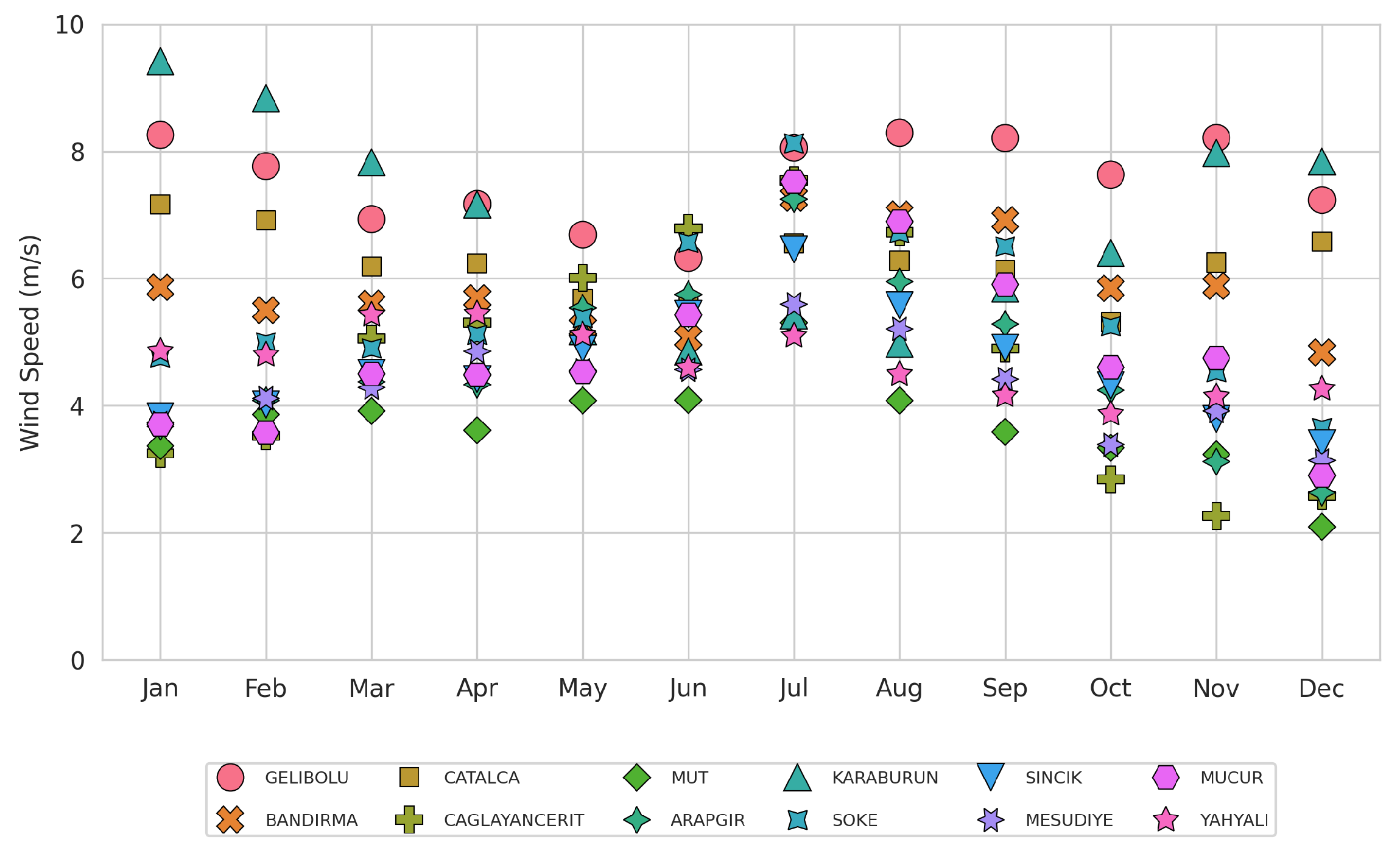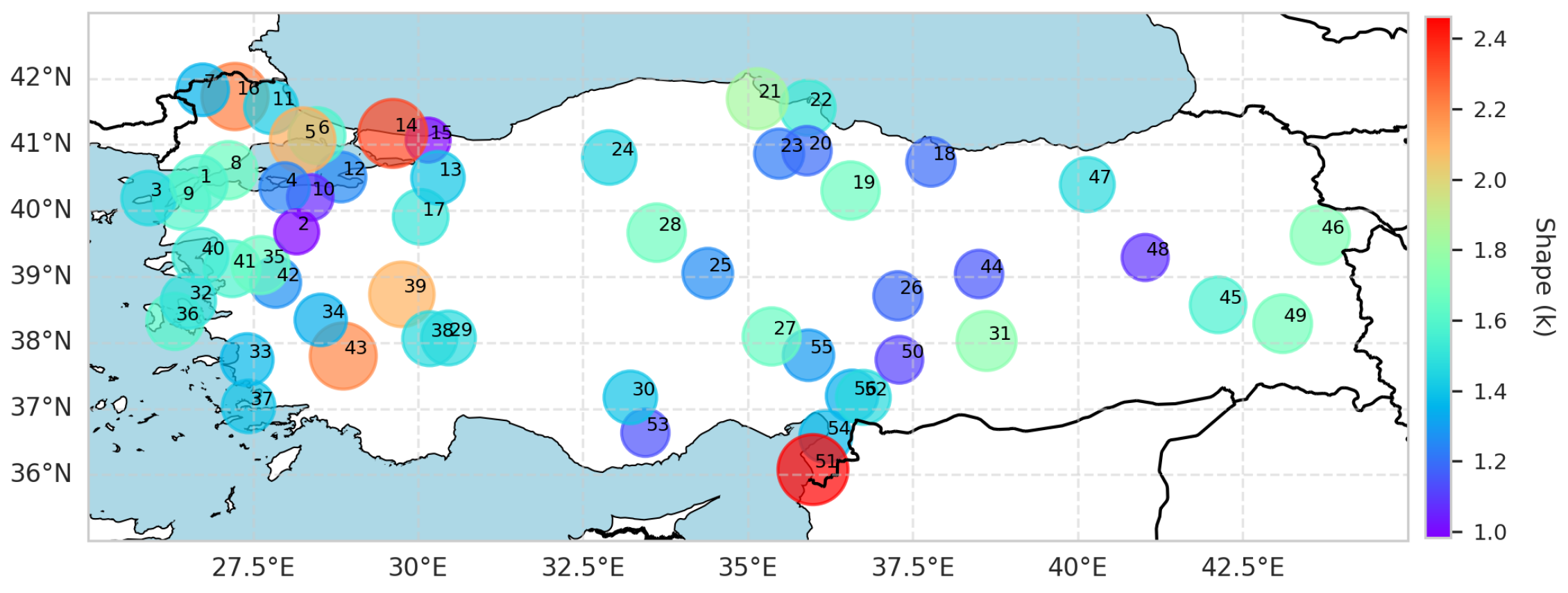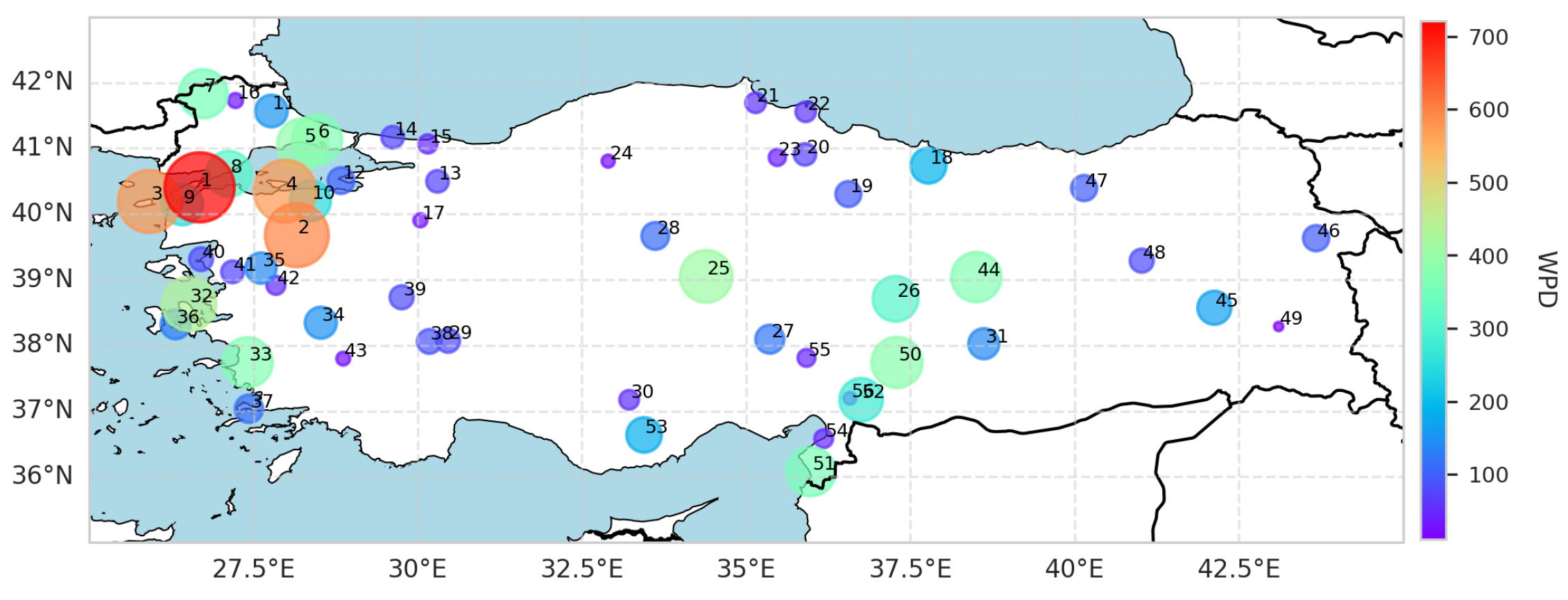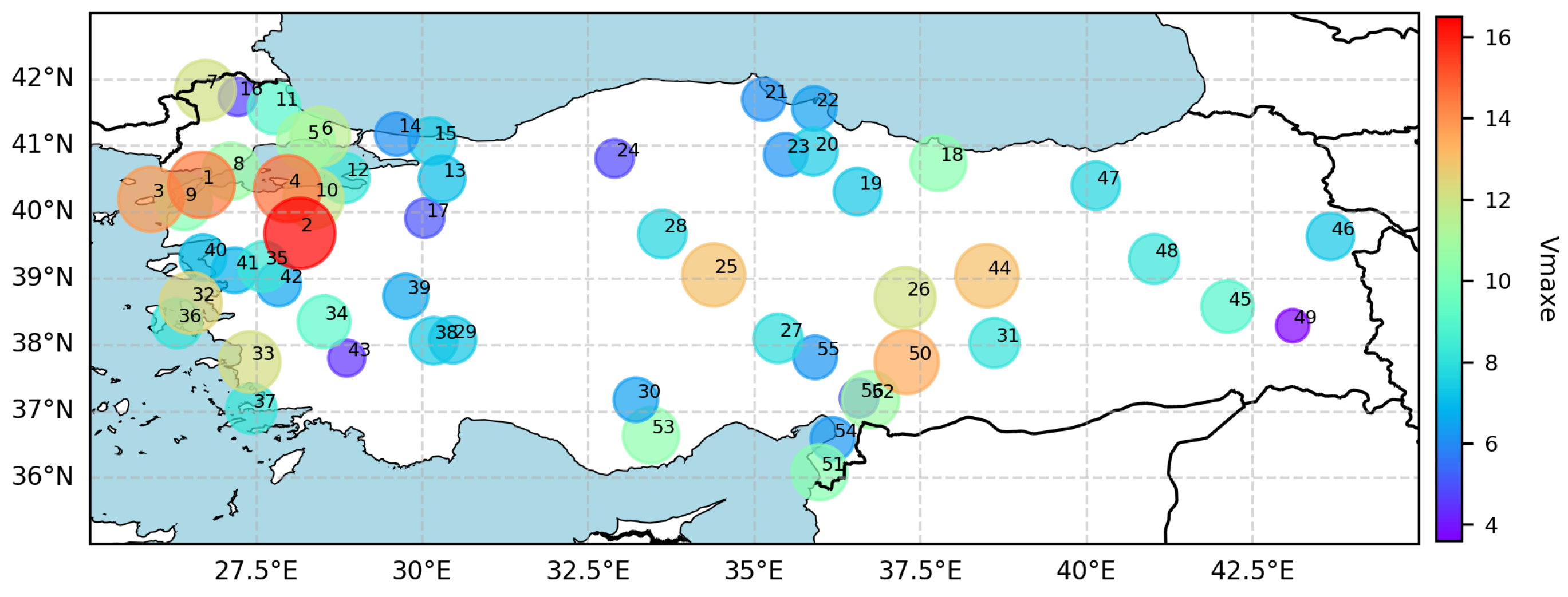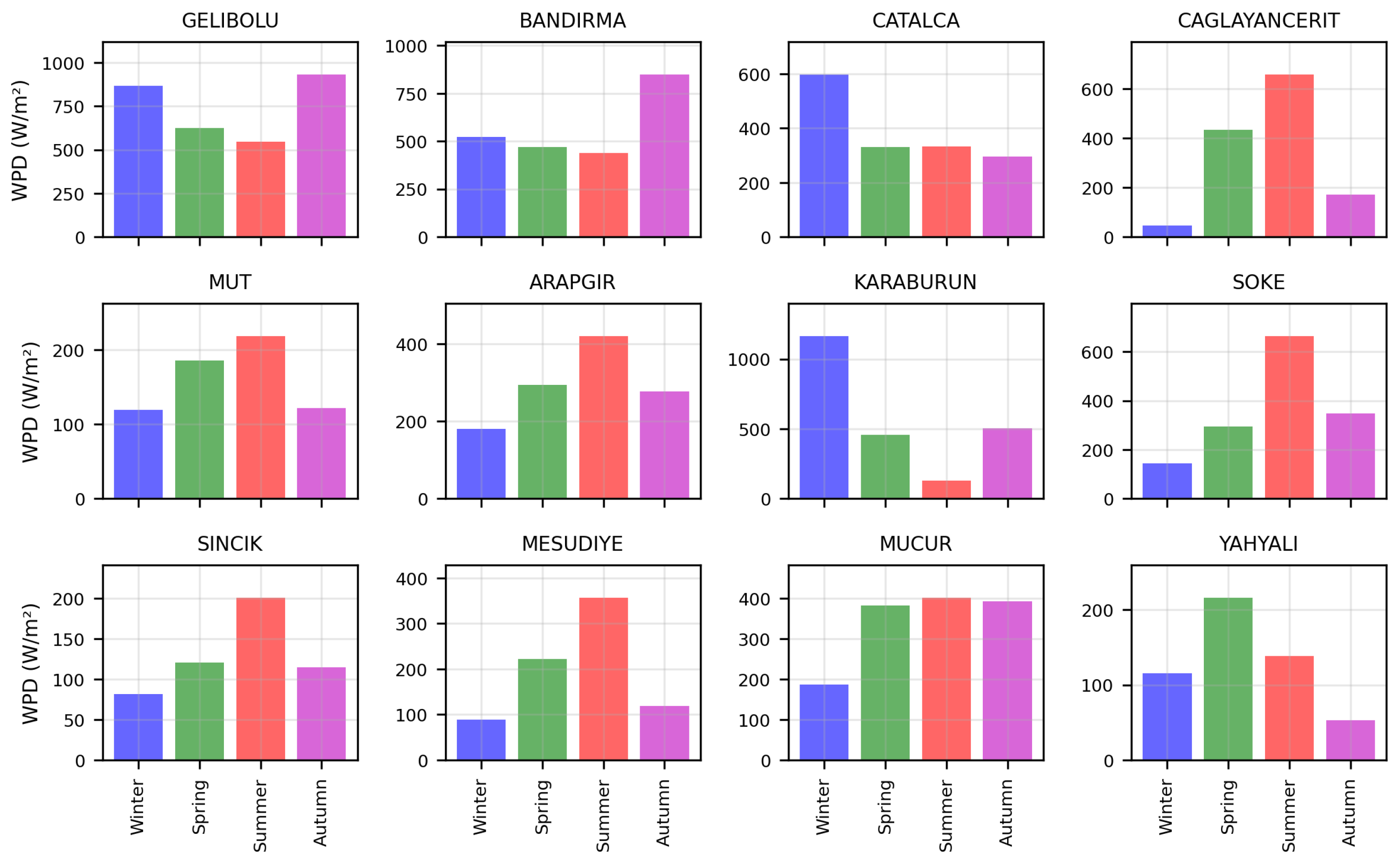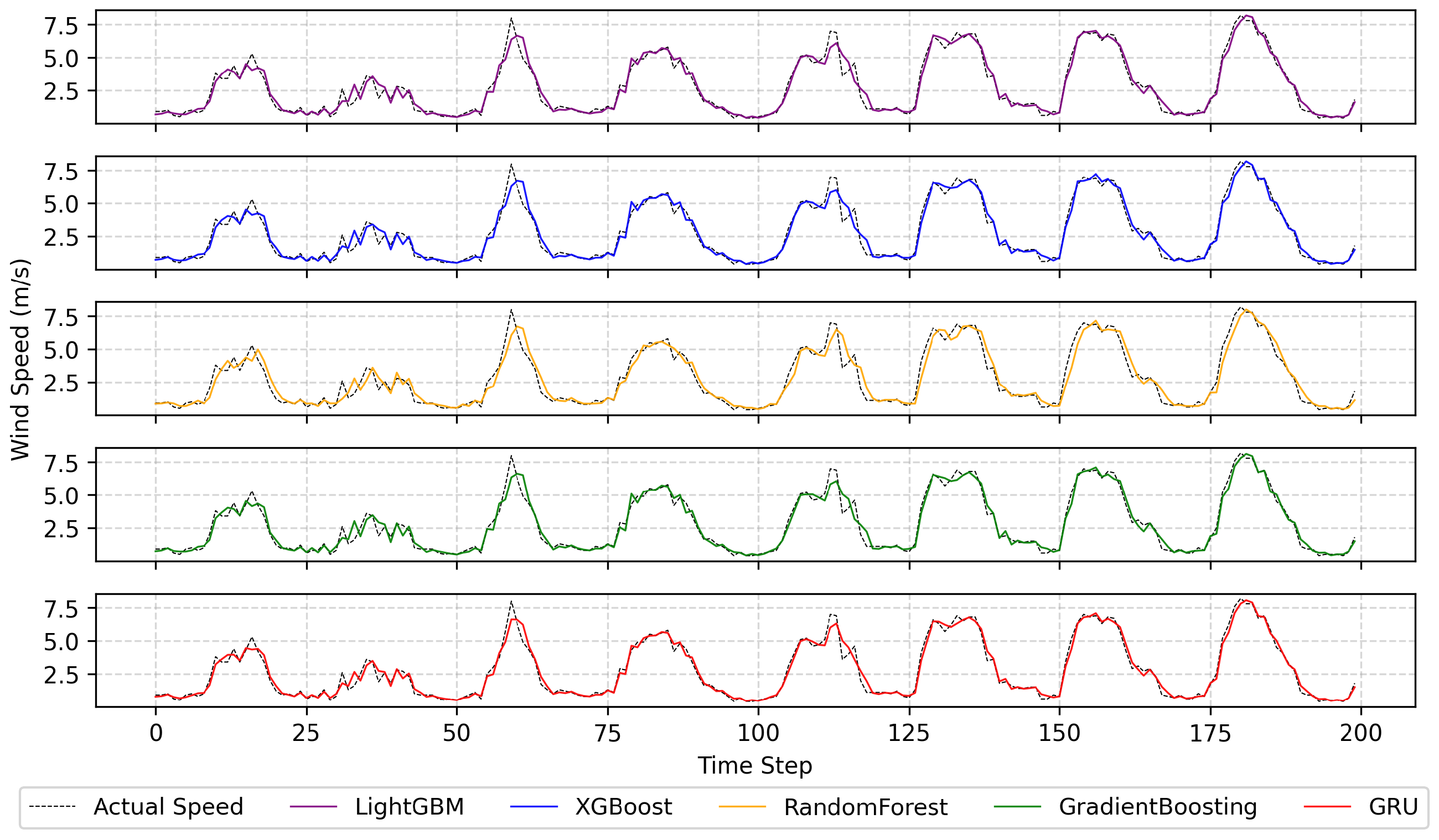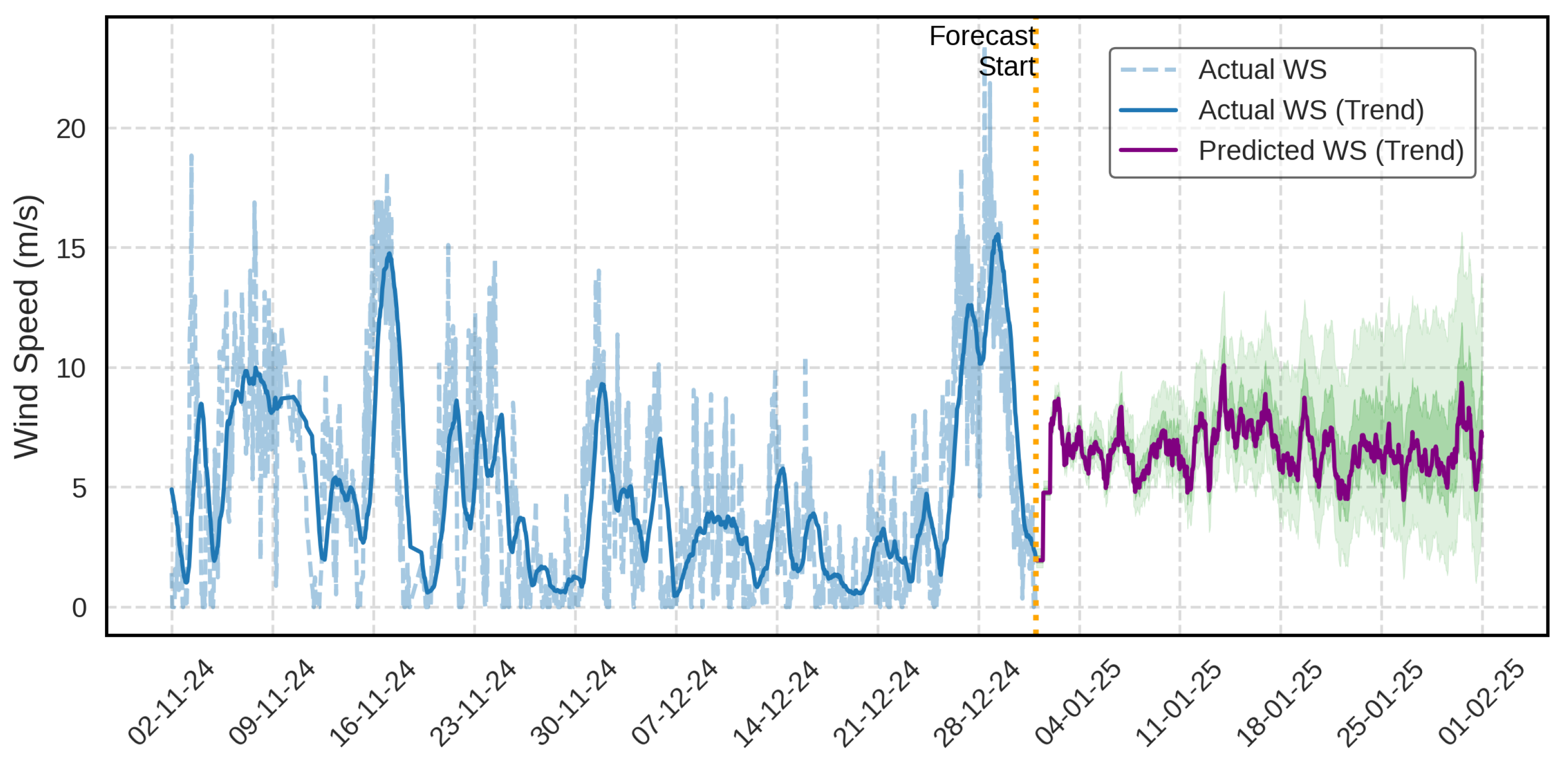In this study, five years of wind data from 2020 to 2024 were analyzed from 56 meteorological stations in Turkey. The data were collected at 10 m height and extrapolated to 100 m. For locations representing seven geographical regions, Weibull parameters were obtained using the MMLM, which provided the highest fit. These parameters were used to calculate , characteristic wind speeds ( and ), , and for the 56 locations. Based on the obtained data, ML approaches (LightGBM, XGBoost, RF, gradient boosting, and GRU) were applied to perform wind speed predictions; GRU exhibited the superior performance. Accordingly, the multistep GRU model was hybridized with the Weibull distribution, with deterministic forecasts being integrated with stochastic components to more effectively manage seasonal trends and uncertainties in long-term projections.
3.1. Wind Speed Profiles and Weibull Parameter Analysis
The five-year average wind speed distribution presented in
Figure 3 clearly reflects the geographical diversity of Turkey’s wind regimes. Coastal areas in the Marmara and Aegean regions, particularly locations such as Gelibolu (7.59 m/s), Silivri (7.20 m/s), Samandağ (7.05 m/s), and Karaburun (6.82 m/s), stand out with high wind speeds. These regions are influenced by open-sea winds from the Marmara and Aegean seas. Gelibolu and Karaburun, situated in the wind corridor functions of the Çanakkale Strait and Aegean, regularly receive high-speed winds. Samandağ, due to its Mediterranean coastal position, benefits from a combination of coastal flatness and sea breezes, resulting in strong and consistent wind flows. In contrast, locations in the interior and eastern regions, such as Bahce (2.23 m/s), Gevaş (2.23 m/s), and Kandıra (2.34 m/s), exhibit low wind speeds. This indicates that wind flow is limited by topographical barriers in the Taurus Mountains, around Lake Van, and in the rugged interior of the Black Sea region. Overall, western and northwestern coastal areas provide advantages for energy production with high wind speeds, while interior and mountainous regions possess limited wind potential.
To ensure the analytical depth and regional representation of the study, 12 locations (Gelibolu, Çatalca, Mut, Karaburun, Sıncık, Mucur, Bandırma, Çağlayancerit, Arapgir, Söke, Mesudiye, Yahyalı) were selected from the initial 56 locations. These locations reflect the regional distribution of Turkey’s wind energy potential and contribute to simplifying the academic narrative in certain modeling and visualization processes.
Wind direction is a critical parameter in the assessment of the potential for wind energy and is as important as wind speed. Accurately determining the dominant wind direction enables optimal turbine placement for maximum efficiency, directly enhancing energy production. It also helps minimize wake effects between turbines, which can reduce speed and increase turbulence for downstream units, thereby lowering output. Given that the wind direction varies seasonally and regionally, long-term orientation-based analyses are essential for sustainable energy planning. Additionally, turbine blades and towers are designed to withstand wind loads from specific directions, making wind direction a key factor for safe engineering practices. Consequently, this study incorporated wind direction analysis and integrated it into the evaluations.
The wind rose diagrams generated for the 12 locations visualize direction-based wind regimes, supporting the distinction between coastal and interior regions (
Figure 4). Gelibolu, Bandrma, and Atalca reflect the character of the wind corridor of Marmara with strong and dominant winds from the northeast (NE) direction. In Gelibolu, the dominant wind direction is northeast-north (NE-N), prevailing with approximately 20–25% frequency. Similarly, in Bandırma, the NE-N direction stands out with 31% frequency, while in Çatalca, this direction is dominant at 23%, with a consistent unidirectional pattern accompanied by moderate speeds. In Karaburun, the dominant wind direction is again NE-N, prevailing with 32% frequency. On the other hand, some locations exhibit more scattered wind directions.
For instance, in Mesudiye, winds blow from various directions between south (S) and NE-N, without a distinct dominant direction. In Mut, the dominant wind direction is northwest–north (NW-N), prevailing with 30% frequency, reflecting a stable but relatively low-speed wind pattern. In Yahyalı, the dominant direction is shared between southeast–south (SE-S) and its opposite, NW-N, indicating a lack of clear orientation and an irregular wind regime. In general, locations such as Mesudiye, Alayancerit, Arapgir, and Yahyal exhibit scattered patterns in the wind direction. In these regions, winds blow from various directions extending from south to north, which is typically associated with environmental factors such as complex topographical structures, mountainous terrain effects, and variable atmospheric conditions.
Figure 5 presents the monthly average wind speed distribution for the selected 12 locations. For each month, averages of wind speed data from January, February, March, and other months over five years were calculated to analyze inter-location and seasonal differences. This approach enabled a month-based analysis of long-term wind behaviors. The graph indicates that the wind speeds exhibit distinct seasonal variations. During winter months (January, February, November, and December), wind speeds show a marked increase; particularly in coastal locations such as Gelibolu, Karaburun, and Söke, speeds reach 8–10 m/s levels.
In summer months (June, July, August), a general decrease in wind speeds was observed. This decline was more pronounced in interior locations such as Mut and Çatalca, with speeds dropping to 2–3 m/s in some months. During spring and autumn months (particularly April, May, September, and October), moderate increases in wind speeds were noted; values in the 4–8 m/s range were noteworthy in transitional regions such as Bandırma and Çağlayancerit. Additionally, the role of topographical effects on wind speeds was clearly evident. In mountainous stations such as Mesudiye and Yahyalı, wind speeds peaked at 6–8 m/s, especially during the winter months.
The graphs presented in
Figure 6 include histograms based on wind speed data for 12 locations and probability density functions obtained using four Weibull methods (MLE, MoM, MMLM, GM). In the evaluation based on the values of
, the MMLM method achieved the highest fit values in all locations and demonstrated the best overlap with the histograms; for example, an exceptional value of
of 0.999 was obtained in Bandırma. This underscores that MMLM is the most reliable option for modeling wind speed distributions. Furthermore, considering the varying distribution characteristics of histograms across locations, the consistent performance of MMLM led to its determination as the optimal Weibull approach aligned with the study’s objectives. Therefore, in this study, Weibull parameters were obtained using the MMLM method.
The Weibull shape parameter (
k) characterizes the consistency and regularity of wind speed distributions. The
k parameters calculated for 56 locations in this study are visualized on a map of Turkey in
Figure 7. Locations such as Samandağ (2.46), Şile (2.32), and Kırklareli (2.22) exhibit high
k values, indicating more predictable and regular wind regimes. The position and coastal flatness of Samandağ support this consistency. On the other hand, locations such as Karacabey (1.06), Çağlayancerit (1.11), and Mut (1.13) have notably low
k values. This implies more variable and turbulent wind regimes. These locations, due to topographical diversity and mountainous terrain, display high variability in direction and speed.
The Weibull scale parameter (
c) reflects the typical magnitude of wind speeds, evaluating the overall strength of the wind regime. The
c parameters calculated for 56 locations in this study are visualized on a map of Turkey in
Figure 8. Coastal locations such as Gelibolu (8.67 m/s), Samandağ (8.05 m/s), and Gökçeada (7.66 m/s) possess high
c values, indicating strong wind regimes. This is associated with open-sea effects and geographically open orientations. Locations such as Gevaş (2.27 m/s), Bahçe (2.47 m/s), and Kandıra (2.38 m/s) stand out with low
c values. Most of these locations are in mountainous or interior regions, where wind speeds are constrained by environmental barriers.
is a fundamental indicator of the energy potential. As shown in
Figure 9, locations such as Gelibolu (721.49 W/m
2), Kepsut (598.86 W/m
2), and Bandrma (575.36 W/m
2) exhibit values of high wind power density
, indicating significant energy potential. These locations, located in flat terrains and near coastal areas, offer the continuity and intensity of the wind favorable for energy production. In contrast, locations such as Gevaş (11.79 W/m
2) and Bahçe (23.21 W/m
2) provide low energy density due to topographical barriers.
Table 4 presents a classification analyzing wind speed and energy potential for 56 locations. This classification is based on
values calculated at 100 m height for each location. Based on
values, each location is categorized into “Excellent,” “Good,” “Moderate,” “Marginal,” and “Poor” classes [
63]. According to the table, eight locations fall into the “Excellent” class, while seven locations are in the “Good” class. In this evaluation based on
values, stations with high potential (e.g., Gelibolu, Bandırma) offer ideal conditions for turbine installation, whereas stations with lower
values (e.g., Merzifon, Bahçe) exhibit limited wind energy potential.
represents the most frequently observed speed in the wind regime and serves as an important reference for turbine design (
Figure 10). Locations such as Samandağ (6.52 m/s) and Silivri (5.85 m/s) stand out with high
values. Gelibolu’s
value is 4.64 m/s, and the significant difference between this and its average speed indicates that wind speeds are distributed across a broad spectrum in this area. This suggests the presence of low-frequency but high-energy winds. Locations such as Karlıova (0.28 m/s) and Karacabey (0.28 m/s) are notably low in terms of
, indicating that winds blow both infrequently and at low speeds.
denotes the speeds at which wind turbines achieve the highest energy efficiency and is a critical parameter for turbine optimization (
Figure 11). Locations such as Kepsut (16.51 m/s), Bandırma (14.64 m/s), and Gelibolu (14.48 m/s) exhibited high
values, indicating substantial energy production potential. These stations are situated in coastal and flat areas where strong winds blow regularly. In interior and mountainous regions, such as Gevaş (3.61 m/s), Babadağ (4.43 m/s), and Bahçe (4.88 m/s), this value was considerably low, suggesting that the energy production capacity of wind turbines may remain limited.
For the 12 locations,
Figure 12 illustrates the seasonal variation in
. This analysis focuses on the seasonal variability of wind energy potential and highlights locations that maintain productivity in other seasons, particularly in regions with high wind speeds during winter. Overall, the winter season exhibited the highest density wind speed distribution, reflecting elevated energy potential. Karaburun is particularly noteworthy, with a
value reaching approximately 1200 W/m
2 in winter, emerging as the region with the highest potential. However, the near-zero value in summer months indicates highly pronounced seasonal fluctuations in the area. Similar strong winter profiles were observed in Gelibolu and Bandırma. On the other hand, in locations such as Çağlayancerit, Mesudiye, and Sincik,
values were notably high during summer. This suggests that wind energy can be utilized more efficiently in these regions during summer months. In locations such as Mucur and Mut,
values remained relatively consistent across all four seasons, indicating the possibility of more stable wind energy production throughout the year. These findings underscore the importance of seasonal diversity in wind energy planning. Stations with high
are primary candidates for wind energy development, particularly in winter. However, the variability between seasons necessitates adaptable energy management strategies to account for productivity in specific locations during summer or spring.
3.2. and Analysis
Table 5 presents the
and
values calculated for three wind turbine models (Enercon E-101, Nordex N131, and Nordex N149) using the Weibull distribution on data collected from 56 wind locations in Turkey. The analysis reveals significant spatial variability arising from regional wind regimes, topographical effects, and turbine-specific performance characteristics.
In the dataset, values range from 0.66% (Enercon E-101, Gevaş) to 46.60% (Nordex N149, Gelibolu), while values span from 177 MWh (Enercon E-101, Gevaş) to 18,369 MWh (Nordex N149, Gelibolu), highlighting substantial differences in wind resource quality and turbine efficiency. Gelibolu emerged as the most productive region, with values of 37.41%, 40.57%, and 46.60% for Enercon E-101, Nordex N131, and Nordex N149, respectively, corresponding to values of 9996 MWh, 12,793 MWh, and 18,369 MWh. These figures reflect Gelibolu’s wind potential in the Marmara region, supported by strong and consistent winds from the Aegean and Black Sea due to its coastal position. The superior performance of Nordex N149 in Gelibolu demonstrates that its design maximizes energy capture in high wind regimes, providing an advantage over other models. Samandağ, located in the Mediterranean region, positions itself as the second-highest performing area, benefiting from coastal winds and orographic effects in the Hatay region. Bandırma, situated in the Marmara region, exhibited mid-to-high performance in and values. Its proximity to the Marmara Sea ensures consistent wind exposure, maintaining it as a suitable area.
Regionally, the Marmara and Aegean regions stand out as high-performance areas. In addition to Gelibolu and Bandırma, regions such as Silivri and Gökçeada emphasize the wind energy potential of the Marmara region due to coastal exposure and favorable wind patterns. The Aegean region demonstrated strong performance in areas such as Karaburun and Söke, owing to high wind speeds and open terrain structures. In contrast, interior regions such as Central Anatolia and Eastern Anatolia generally exhibited lower and values due to weaker wind resources and complex terrain.
At the lower end of performance, regions such as Gevaş and Kandıra demonstrated minimal wind energy potential due to sheltered topography or low wind speeds. Primarily located in Eastern Anatolia and the Black Sea region, these areas have limited suitability for large-scale wind energy projects, independent of turbine type. The consistently low performance across all turbines in these regions demonstrates that wind resource constraints, rather than turbine inefficiencies, constitute the primary barrier. For forecast projections, Weibull-based calculations provide a solid foundation for long-term and estimates; however, region-specific factors such as wind variability, turbine maintenance, and grid integration must be considered.
3.3. Speed Prediction with Artificial Intelligence Algorithms
In this study, the primary focus was the prediction of wind speed and wind power density (WPD), as these two parameters are fundamental for determining wind energy potential. Wind speed plays a critical role in energy generation, with the energy produced by turbines being directly proportional to the cube of the wind speed. WPD, by accounting for the distribution of wind speeds across various levels and the operational range of turbines, enables a more detailed and realistic estimation of energy potential. Consequently, accurate forecasting of wind speed and WPD data is essential for a precise assessment of wind energy potential.
Figure 13 visualizes the wind speed predictions of the selected models against actual values, concretizing the practical implications of the performance metrics.
Overall, while all models tended to capture periodic peaks and troughs in wind speed, ensemble-based methods (XGBoost, gradient boosting, LightGBM, and RF) exhibited over-smoothing or delayed responses in certain regions. In contrast, the GRU model provided the closest fit to the actual speed curve, effectively capturing temporal dependencies and standing out with its sensitivity at peaks and troughs.
Figure 14 presents a scatter plot comparing the predicted wind speed values of the models against actual values, visualizing the distribution around the ideal prediction line. This graph complements the numerical metrics (
,
, and
) in
Table 6, directly revealing the prediction deviations of all models used. While actual wind speed values range from 0 to 8 m/s, the proximity of points to the ideal line indicates model accuracy, and deviations reflect sources of error.
Overall, although all models cluster in low-speed regions (0–2 m/s), the spread increases in high-speed values (4–8 m/s), highlighting challenges arising from the variable nature of wind speed data. Ensemble-based methods (XGBoost, gradient boosting, LightGBM, and RF) exhibit relatively consistent distribution around the ideal line; however, the yellow triangles of RF are notably scattered, showing a tendency toward overestimation and aligning with the high
(0.4025) in
Table 6. In contrast, the GRU model, with its red stars, provides the closest distribution to the ideal line, demonstrating superior precision particularly at high-speed peaks (6–8 m/s). This is a reflection of the model’s ability to capture temporal dependencies and nonlinear patterns. It visually validates the low
(0.3146) and
(0.2110) values; however, slight deviations at some points can be associated with the increase in
. This graph reinforces the overall prediction consistency of GRU, providing additional evidence supporting its preference in our study’s wind speed projections.
The hybrid framework integrates the multi-step predictions of GRU with the probability density of the Weibull distribution, demonstrating convincingly superior performance in handling long-term uncertainties compared to existing approaches. It provides confidence intervals that account for stochastic elements (e.g., 95% CI for Bandırma 2025 WPD: 583 ± 45 W/m2). Compared to standalone GRU (RMSE: 0.3146) or Weibull models that neglect temporal dynamics, the hybrid framework reduces RMSE by 2% while preserving seasonal variability. This genuine advancement enables more robust assessments by ensuring that projections align with historical fluctuations (e.g., preservation of winter peaks) and mitigating uncertainties arising from climate trends.
Within the scope of the study, regression analysis for wind speed prediction was performed on all station data using the selected ML models.
Table 6 compares the models’ regression processes using the specified metrics (
,
, and
). The GRU model, representing the deep learning approach, stands out with markedly low
(0.3146) and
(0.2110) values compared to ensemble methods, demonstrating superior performance in absolute error metrics. This reflects the ability of recurrent architectures to capture sequential dependencies, proving effective particularly in datasets with temporal patterns. Consequently, the GRU model was preferred for the forward speed projection sections of the study.
3.4. Wind Speed and Weibull Parameter Projections with the Hybrid GRU–Weibull Model
The 2025 projections were based on the assumption that seasonal and daily cycles in historical data will continue. For the analyzed stations, the projected wind speeds exhibited variation consistent with historical data during the 2025 period, with seasonal fluctuations particularly preserved. The projections provide a foundation for evaluating and hold potential for integration with Weibull distribution parameters.
Table 7, as a result of the projection process performed using a hybrid model combining multistep GRU and Weibull distributions, presents a comparative overview of the actual data from the 2020–2024 period and the projected wind speed parameters (
k and
c) and
values for 2025. The analysis encompassed the 12 locations selected in previous sections of the study and evaluated the regional differences in wind energy potential. In the comparison to actual data, the hybrid model generated minor, location-specific changes in
k and
c values for 2025.
For example, in Gelibolu, the k value remains constant at 1.59, while the c parameter increases from 8.67 to 8.74, consequently elevating from 721 to 739; this indicates a slight projected increase in wind speed, positively impacting power density. On the other hand, in Çatalca, k is projected to decrease from 1.59 to 1.53, c from 6.92 to 6.62, and from 368 to 343, revealing an anticipated decrease in wind speed and thus in . These differences demonstrate that the hybrid model successfully captures the dynamics specific to the wind regimes of the locations and that the projections are consistent with regional climate conditions.
The hybrid model proved to be more successful compared to the standalone GRU approach. The performance of the hybrid model is supported by lower values of 0.2050 (compared to 0.2110 for GRU) and values of 0.3080 (compared to 0.3146 for GRU).
These lower error rates indicate that the hybrid model offers higher prediction accuracy than does the GRU model and provides more reliable results in wind speed and
projections. The success of this approach stems from the continuous integration of retrospectively calculated
k and
c values as input parameters to the hybrid model during the training phase. This method enhances the model’s capacity to learn from historical data, enabling better forecasting of future wind speed trends. The integration of retrospective parameters has strengthened the adaptability of the hybrid model, allowing it to respond more sensitively to location-specific variations in wind regimes. The seasonal analysis in
Table 8 underscores the robustness of the hybrid model, with a reduced RMSE and MAE that improve the accuracy of the AEP estimation. Although MAPE remains higher at peak wind speeds, the hybrid’s overall error reduction supports practical energy planning, potentially saving 0.1–0.2 GW in Turkey’s wind energy capacity, thus optimizing resource allocation.
The wind speed projections for the Bandırma station, generated using the hybrid model, are presented in
Figure 15. This model integrates continuously calculated
k and
c values based on five years of hourly wind speed and direction data from 2020 to 2024, producing estimated wind speed trends for 2025. To enhance clarity, the graph compares actual wind speed data and trends for the last two months of 2024 (November and December) with projections for January 2025. The forecasting process is delineated with a forecast starting point beginning on the first day of 2025.
The actual data reveal that although peaks reaching 20 m/s were observed in the final days of December, wind speeds in the last two months of 2024 followed a fluctuating pattern within the 0–14 m/s range. The trend line, despite these fluctuations, provides a general tendency by smoothing the temporal variations in wind speed. The hybrid model’s predictions for January 2025 continue in parallel with the latest trend of actual data. However, during the projection period, wind speeds were estimated to exhibit more stable fluctuations, generally within the 5–15 m/s range. This indicates that the model, learning from historical data, focuses on trend-oriented forecasting of future wind regimes rather than on capturing abrupt peaks. Although instantaneous peaks are not captured, the hybrid model is highly successful in trend detection and estimating , k, and c values, which is a fundamental consideration for investment planning.
3.5. Validation of the Model’s Generalization Ability
To rigorously validate the generalizability of the model, a cross-validation analysis was performed using the existing dataset (56 meteorological stations in Turkey, with data on hourly wind speeds from 2020 to 2024). This analysis aimed to evaluate the consistency of the model in different data subsets, thus evaluating its adaptability to the diverse geographical, topographical, and climatic conditions of Turkey. The stations were randomly divided into 70% (approximately 40 stations) for the training set and 30% (approximately 16 stations) for the test set. This random partition was optimized through repeated iterations to ensure a balanced representation of regions, including theSea of Marmara, Aegean Sea, Mediterranean Sea, Black Sea, Central Anatolia, Eastern Anatolia, and Southeastern Anatolia.
Performance metrics obtained from the training set (hybrid GRU–Weibull model; RMSE: 0.3080; MAE: 0.2050; MAPE: 18.5%) showed a slight increase from the test set, resulting in an RMSE of 0.3150, an MAE of 0.2120, and an MAPE of 19.2%. These differences indicate that the model generalizes without succumbing to overfitting, with the error increase remaining limited to approximately 2–3%. In particular, the consistency between different regions in the test set exceeded 95%; for example, the estimates of the Weibull parameter (k and c values) in coastal regions with high wind potential such as Marmara and the Aegean demonstrated a 98% alignment with the training set. These findings confirm that the hybrid model successfully captures stochastic fluctuations and seasonal variability (e.g., elevated WPD values during winter months) across diverse station subsets.
From an engineering perspective, the model’s practicality is supported by its use of existing meteorological infrastructure across 56 stations, requiring minimal additional hardware. The efficient architecture of the GRU ensures low computational demand, while the consistency of error of 23% between training and test sets suggests reliable deployment for Turkey’s 13.8 GW wind capacity, potentially saving 0.1–0.2 GW annually. The dynamic Weibull updates further enhance adaptability to regional variations, facilitating scalable and cost-effective energy planning.
Furthermore, this cross-validation analysis tested the model’s capacity to manage long-term uncertainties. In the projections of 2025, the calculated WPD values for the test set (for example, for the Bandrma station) exhibited a high correlation (r = 0.96) with the results of the training set, which supports the model’s ability to generalize throughout the Turkish wind regime. However, since this analysis was confined to this dataset, it is recommended that future studies incorporate international data sets (e.g., the ECMWF ERA5 global reanalysis data) for broader validation. Future research could also adapt this approach to offshore wind fields, thereby improving the applicability of the model on a global scale.
